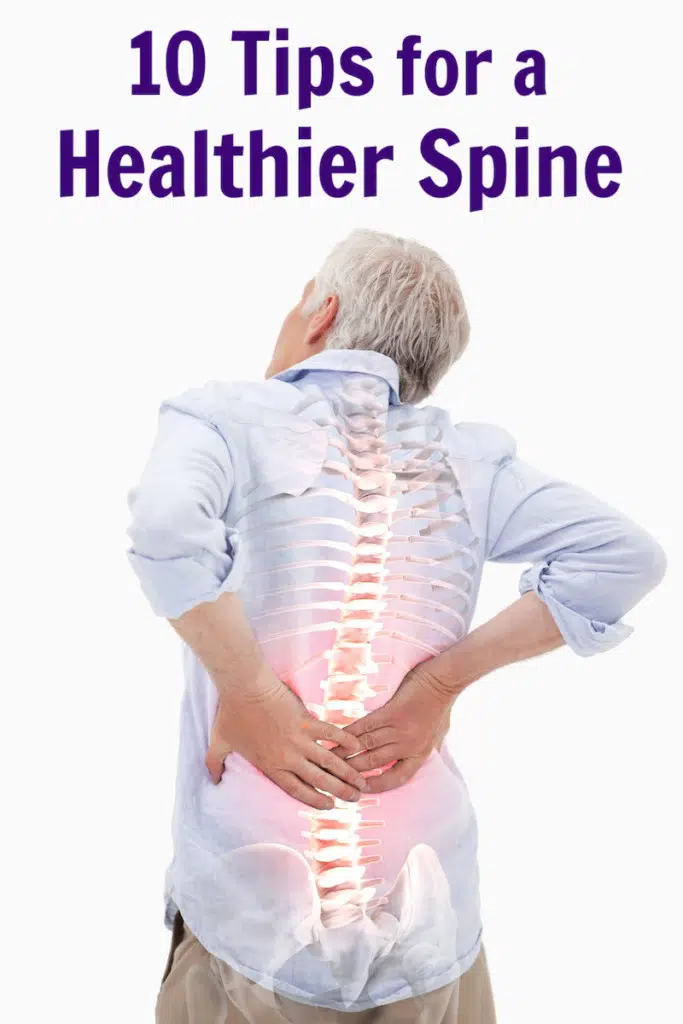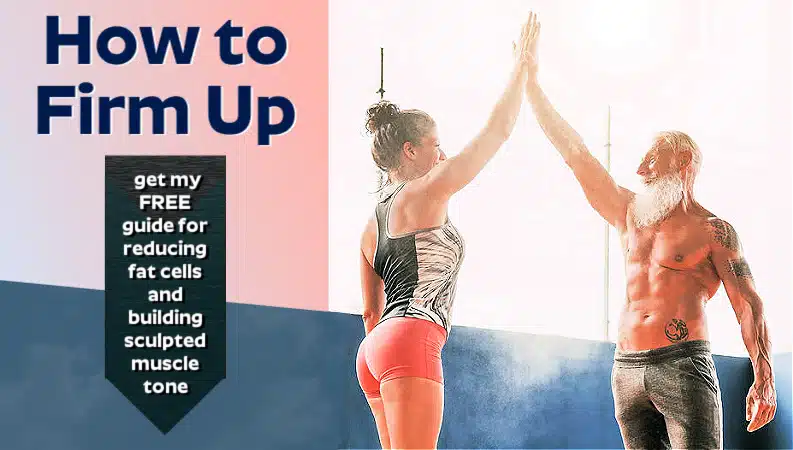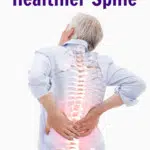Spine health should be one of your top self-care priorities for the simple reason that your spine is one of the most important parts of your body. Poor spine health leads to kyphosis – the dreaded neck hump.
Fortunately, kyphosis can be reduced and spine health restored.
You can say goodbye to your neck hump! Below, I share ten tips that will improve your spine health so you can live a vibrant and active life after the age of fifty. Also included is a video with the mobility movements and strengthening exercises that help reduce neck hump and lower back discomfort.
How to Make Your Kyphotic Neck Hump Disappear
Lower within this article, I’ve included a set of simple exercises and mobility movements designed to remedy one of the biggest problems for those over 50: kyphosis.
Kyphosis is that hump that begins to appear on the upper back. Usually, it’s also accompanied by a craning-forward neck.
What is that neck hump made of? Probably calcium, bone, and fat deposits. The prevailing theory is that it’s the body’s way of trying to create balance.
The more time you spend with your neck craned forward looking down at your phone, the more the body wants to prevent you from toppling over – so it adds material to the back side of your torso to try to create symmetry.
The frightening aspect of having kyphosis is that the bigger your neck hump gets, the faster your neck cranes forward (and vis versa) and the more misaligned your spine becomes.

It’s easier to remedy kyphosis if you address the problem earlier in the condition rather than later.
You might think that kyphosis doesn’t apply to you, but the only way to know for sure if you have the beginnings of a neck hump is to have someone use your phone to take a photo of you standing to the side.
A candid side-profile pic of you standing as you normally stand will tell you a lot:
- Look at the photo objectively and honestly to determine if your posture could be improved.
- The chances are, yes, your spine could be longer, and your pectorals and anterior deltoid muscles could be loosened.
Why Is A Healthy Spine Important?
Without the foundation of the spine, humans would be invertebrates – like worms, insects, or jellyfish.
The spine supports your head and allows you to move freely and vertically, so it’s crucial to take care of your spine and keep it strong, flexible, and aligned.
Your spine comprises bone (vertebrae), discs, muscles, and ligaments. It supports your head, neck, and trunk, and allows you to move freely. It also protects your spinal cord — the bundle of nerves that carries messages between your brain and the rest of your body.
A healthy spine is vital for many reasons. It helps you:
- stand tall and sit up straight
- bend and twist
- lift things
- and carry your body weight.
These 10 Factors Encourage Spine Health
When your spine is not healthy, it can cause pain (especially in your lower back and neck) and limit your ability to move. These factors provide a solution to kyphosis or neck hump:
1. Maintain A Healthy weight
People come in all shapes and sizes, and that diversity is a beautiful thing. However, when it comes to spine health specifically, maintaining a weight appropriate for your body type is one of the best things you can do.
Excess weight puts compression on your back and neck muscles and increases the risk of developing conditions such as herniated discs and osteoarthritis. Once you can maintain the weight that is uniquely right for you, it will be easier to keep your spine healthy.
2. Develop Good Blood Flow with Strategic Cardio
The spinal discs need an ample supply of blood to stay healthy.
When you are too sedentary, there is extra pressure on your discs, which can reduce the flow of blood and cause them to degenerate. Cardiovascular exercise – both steady-state and anaerobic – can help improve blood flow throughout your body.

As you probably know, smoking tobacco cigarettes decreases the blood flow to your spine and can contribute to the degeneration of the spinal discs.
2. Build A Strong Core for Spine Health
Core muscles, in particular, help support your spine and keep it stable. When core muscles are weak, it can lead to instability and pain.
3. Improve Your Flexibility to Avoid Neck Hump
Staying flexible is essential for your healthy spine. When your muscles and ligaments are tight, it can strain your spine.
Activities that are highly effective at improving flexibility include mobility drills, swimming, yoga, Pilates, and stretching. Yoga, in particular, can help decompress the spine and create more room between the discs.
4. Remedy Poor Posture: Use a Rolled Towel for Neck Hump
Poor posture can lead to muscle strain, disc degeneration, and nerve compression. It’s helpful to maintain vertical length in your posture when sitting, standing, and moving.
Good posture helps reduce strain on your spine. Keep your shoulders back and your head up when sitting, standing, or walking.
Because a neck hump is characterized by an excessive rounding of the upper back and forward positioning of the head, it’s often associated with poor posture. Using a rolled towel can provide a simple and effective way to help alleviate this issue by promoting better alignment and reducing strain on the affected areas.
Here’s how you can use a rolled towel to help reduce a neck hump:
- Preparation: Find a medium-sized towel and roll it up tightly to form a cylindrical shape.
- Placement: Sit or stand with your back straight and your head facing forward. Place the rolled towel horizontally behind your upper back, just below the neck hump. The towel should run parallel to your spine.
- Positioning: Gently lie back, allowing your upper back to rest on the rolled towel. Ensure your head is also supported by the towel, but keep your neck neutral (avoid excessive forward or backward bending of the neck).
- Relaxation: Take a few deep breaths and allow your body to relax into this position. The towel will help to promote a gentle extension of the thoracic spine, counteracting the forward curvature associated with the neck hump.
- Duration: Aim to hold this position for about 5-10 minutes daily. You can gradually increase the time as your body gets more comfortable with the stretch.
- Regularity: Consistency is key. Perform this move regularly to see improvements in your posture and neck hump over time.
This move is more of a passive stretch, but further below, I include some helpful exercises also. Your medical doctor, chiropractor, or physical therapist can provide personalized guidance to ensure that the rolled towel stretch or the other exercises are safe and appropriate for your specific situation.
5. Eat a Healthier Diet
Eating a healthy diet is important for your overall health, and it can also help with spinal wellness. A diet that is abundant with vegetables and quality proteins can help to keep your discs healthy and prevent degeneration.
In particular, many people over 50 have found that an anti-inflammatory diet helps to reduce inflammation and discomfort in the spine and joints.
A diet higher in food-based micronutrients – calcium, magnesium, and vitamin D – will generally be better at maintaining spine health.
6. Reduce Time on Mobile Devices to Improve Neck Hump
Living in the age of technology, it is hard to stay away from screens. However, looking down at your phone or tablet for long periods can lead to neck craning, cervical pain, and stiffness.
Try to take breaks from your mobile devices often – to move your head and neck around, and avoid looking down for lengthy periods.
If it is necessary to use electronic devices that cause neck pain, then wearing a neck pillow might help. However, it is best to consult a spine specialist if neck pain persists.

7. Do Strength Training Regularly and Try These Specific Exercises
Physical activity helps increase the flow of blood to the spinal discs, which helps keep them healthy. It also strengthens the muscles that support your spine, which can help prevent pain and injuries.
Resistance training helps keep your spine strong and flexible. It also helps maintain the health of the discs in your spine.
When lifting, use your legs, core, and glutes instead of your lower back to avoid putting strain on your spine.
If you already have the beginnings of a kyphotic neck hump, you must often lay on your back – probably on a mat on the floor. Doing so will help your vertebrae and muscles properly reorganize.
You will have to put a small, rolled up under the back of your head as the neck hump will prevent your head from relaxing fully and comfortably onto the mat.
Similarly, when you do movements reclining on a foam roller – which I highly recommend you do – you will also need a rolled-up towel under your head (this is when you lay back on the roller so that it sits directly under your backbone, supporting you all along the spine).
You’ll need to loosen the tight tissues of the neck hump area:
- I recommend leaning back against the wall, with a small ball between the wall and your back.
- Gently and subtly move your torso around the ball a bit, exploring those tight areas in and around the neck hump.
- Apply a little pressure, pushing into the ball with your back. Proceed cautiously; you’re not trying to push into the actual spinal vertebrae, but rather, the tight areas surrounding the spine.
- You can use a tennis ball, lacrosse ball, or therapeutic mobility ball.
Next, remove the ball and sit up with your back against the wall again. Sit tall with your arms extended in front of you. Now, squeeze your shoulder blades into one another a bit as you press the back of your shoulders into the wall. Do this many times until you feel your scapula and posterior deltoids fatiguing.
To remove slouch, you’ll also need to loosen the tight muscles of your chest and the fronts of your shoulders. For that, I recommend:
- foam-rolling exercises
- and mobility movements.
As you do these recommendations regularly and begin to see and feel improvement in your flexibility and neck hump, then I suggest you also add these postures and stretches to your weekly regimen:
A final note on exercising with neck hump: when doing any seated or standing exercise, endeavor to allow your spine to move upward out of the hips vertically. I don’t mean stiff-as-a board spine, because – in truth – the spine is meant to have supple curves. But lengthen the spine upward in a relaxed way, allowing your shoulders to drop away from your ears and gliding back.
8. Wear Comfortable Shoes for Spine Health
Subpar shoes are hard on the human body. Try not to spend too much time in uncomfortable shoes – common culprits (for men )are dress shoes that are too narrow and (for women) shoes with high heels – that put extra stress on your spine and lead to pain. Shoes that squeeze your toes tightly together are problematic.
The wider apart your toes, the more foundational support your feet can provide for your body weight. Scrunched-up toes mean your spine will have to pick up the slack that your feet should have provided.
9. Sleep On A Better Mattress
A mattress that is too soft or too firm can cause back pain.
Generally, it can be good for the spine to sleep on your back – so you’ll also need the right pillow that provides enough lift for your neck but not too much. Ask your medical doctor or chiropractor.
10. Center Your Mind
Stress makes everything worse.
Take time for mindful meditating and deep breathing in silence, particularly when suffering from spinal discomfort.
Despite not working for everyone, studies show meditation can effectively reduce pain in your neck and lower back.
The Bottom Line on Spine Health and Neck Hump
We often don’t think about our spinal health until we experience pain or other symptoms that alert us to a problem. By then, it may be too late to prevent severe damage.
It’s essential to take steps toward maintaining a healthy spine throughout your life. If you experience pain, a physical therapist can help you strengthen the muscles that support your spine. Don’t wait until the problem gets worse before seeking medical help.
Interestingly, not only does the condition of your spine impact your physical health, but it also greatly influences how people perceive you. People with strong, supple spines appear younger when they move across a room. They project confidence and appear trim and highly capable. This is the power of good posture.
Your spine is an essential part of your body, and it’s important to take steps to keep it healthy. By maintaining a healthy weight, exercising regularly, and practicing good posture, you can help prevent pain and injuries.
If your neck hump is pronounced and often uncomfortable, I encourage you to consult your medical doctor, who might steer you toward a qualified physical therapist and chiropractor.
These ten tips improve spine health – reducing neck hump and strengthening the backbone – so you can look better and live more vibrantly.
Additional Sources on Spine Health and Preventing Neck Hump:
Research on How Mindfulness Alleviates Neck Pain – https://www.ncbi.nlm.nih.gov/pmc/articles/PMC4941786/
Abdominal and Lower Back Training for Injury Prevention and Overall Wellness – https://www.ncbi.nlm.nih.gov/pmc/articles/PMC3806175/
Poor Spine Health Can Impact Memory – https://www.ncbi.nlm.nih.gov/pmc/articles/PMC3940958/
